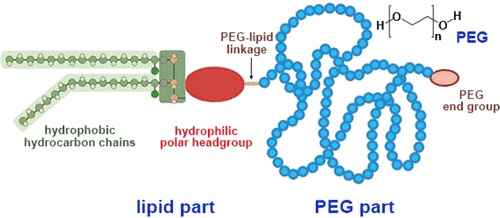PEG Lipids, or PEGylated lipids, are a class of polyethylene glycol (PEG) derivatives attached to a lipid moiety, such as 1,2-dimyristoyl-sn-glycero-3-phosphoethanolamine (DMG) or 1,2-distearoyl-sn-glycero-3-phosphoethanolamine (DSPE). These conjugates are widely used in pharmaceutical formulations, particularly in lipid nanoparticle (LNP) drug delivery systems, to enhance the stability and circulation time of liposomes and other nanoparticles.
Structure of PEG Lipids
PEG lipids are amphiphilic molecules composed of three key components: [1]
- • Hydrophilic PEG chain: A non-ionic, biocompatible polymer known for its high hydrophilicity and ease of synthesis.
- • Linker: A chemical bridge (e.g., phosphate or glycerol) connecting the PEG chain to the hydrophobic anchor.
- • Hydrophobic anchor: Typically an alkyl chain or lipid moiety that embeds into lipid membranes or nanoparticles.

Figure 1. Scheme of the PEG–lipid structure. Source: reference [2]
In their structure, one end of the PEG chain is covalently attached to the hydrophobic anchor via the linker. This unique architecture combines PEG's advantageous properties—including biocompatibility, steric stabilization, and reduced immunogenicity—with the membrane-anchoring capability of lipids. PEG lipids are widely used to enhance the stability, circulation time, and targeted delivery of lipid-based drug carriers.
PEG-Lipid Design Impacts LNP Performance
Several structural factors influence PEG-Lipids’ performance:
PEG Structure
- • Length: Both short and long PEG chains can be more likely to induce the ABC phenomenon, affecting immune response.
- • Density: The percentage of PEG in LNPs impacts immune reactions, with both low and high densities reducing ABC effects.
- • PEG Structure: Branched PEG-lipids provide better stealth properties than linear ones, enhancing circulation time.
- • Terminal Groups: Modifications at the PEG chain’s end can affect immune response and clearance rates.
Lipid Anchor
- • Size & Charge: Negatively charged phospholipids may activate the immune system via complement activation more than neutral ones.
- • Lipid Chain: The hydrophobic lipid component influences both immune response and drug efficacy.
- • Anchoring Group: Using cholesterol as an anchor improves circulation time and bioavailability.
- • Lipid Linkage: The type of chemical bond (e.g., ester vs. carbamate) affects vesicle stability.
Key Applications of PEG Lipids
PEGylated lipids are versatile tools in modern therapeutics and diagnostics.
Drug Delivery
PEG lipids are essential components in lipid nanoparticles (LNPs), which are widely used for delivering nucleic acid-based drugs, such as mRNA vaccines and siRNA therapeutics. The PEGylation of lipids enhances nanoparticle stability, prevents rapid clearance by the immune system, and improves circulation time in the bloodstream.
- •mRNA Vaccines: PEGylated lipids (PEG-2000) are used in Moderna and Pfizer-BioNTech COVID-19 vaccines to stabilize mRNA within lipid nanoparticles, ensuring efficient delivery and protection against degradation.
- • Anticancer Drug Delivery: PEG lipids are widely used in pharmaceutical LNP formulations for anti-cancer drugs like doxorubicin, irinotecan, and cisplatin, improving their pharmacokinetics and reducing side effects.
- • siRNA and Gene Therapy: PEGylated lipids aid in the delivery of siRNA and gene therapy vectors by forming stable lipid-based carriers. These nanoparticles facilitate efficient cellular uptake and gene silencing for targeted therapies.
Targeted Therapy
By modifying PEG lipids with targeting ligands, researchers can develop smart drug delivery systems that selectively deliver drugs to specific tissues or cells, improving therapeutic outcomes and reducing off-target effects.
Diagnostic Imaging and Theranostics
PEG lipids contribute to contrast agent formulations in medical imaging by improving solubility and stability, enhancing the effectiveness of diagnostic imaging techniques such as MRI and PET scans.
Challenges and Considerations
Despite their benefits, PEG lipids can induce immune reactions, such as accelerated blood clearance (ABC) and complement activation-related pseudoallergy (CARPA), due to the formation of anti-PEG antibodies. Understanding these interactions is crucial for optimizing PEG lipid structures to minimize adverse effects while maintaining their therapeutic efficacy.
Lipid Supplier
As a trusted global supplier of biochemical solutions, Biopharma PEG specializes in high-quality lipid molecules for drug delivery, vaccine development, and nanomedicine. Our extensive portfolio includes PEG lipids (DSPE-PEG, DMG-PEG, etc) and helper lipids (cholesterol, DSPE), essential for liposome and lipid nanoparticle (LNP) formulations. Partner with us to accelerate your innovation in drug delivery and biomedical research.
References:
[1] Poornima Kalyanram, Anu Puri, Anju Gupta (2020) Understanding the Stealth Properties of PEGylated lipids: A Mini-Review. International Journal of Lipids - 1(2):1-20. https://doi.org/10.14302/issn.2835-513X.ijl-20-3457
[2] PEGylated Lipid Nanoparticle Formulations: Immunological Safety and Efficiency Perspective, Rumiana Tenchov, Janet M. Sasso, and Qiongqiong Angela Zhou, Bioconjugate Chemistry 2023 34 (6), 941-960, DOI: 10.1021/acs.bioconjchem.3c00174
[3] https://www.cas.org/resources/cas-insights/ultimate-guide-pegylated-lipid-nanoparticles
Related Articles:
The Role of Four Lipid Components Of LNPs
Application of mRNA-Lipid Nanoparticles (LNPs) In Cancer
Nucleic Acid Therapeutics: Approvals and Potential Blockbusters

